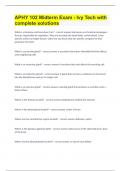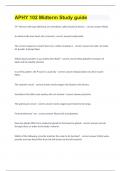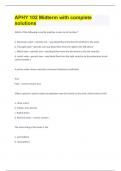APHY 102 Anatomy and Physiology 2
Indiana University
Page 2 out of 13 results
Sort by

-
APHY 102 Midterm Exam - Ivy Tech with complete solutions UPDATED AND VERIFIED
- Exam (elaborations) • 21 pages • 2024
- Available in package deal
-
- $11.39
- + learn more
APHY 102 Midterm Exam - Ivy Tech with complete solutions APHY 102 Anatomy and Physiology 2 What is a hormone and how does it act? - correct answer Hormones are chemical messengers that are responsible for regulation. They are secreted into body fluids, mainly blood. It has specific actions on target tissues, which are any tissue that has specific receptors for that particular hormone. What is a paracrine gland? - correct answer a secretion that enters interstitial fluid but affects only nei...

-
APHY 102 Anatomy and Physiology 2 SPRING Midterm Study guide
- Exam (elaborations) • 10 pages • 2024
- Available in package deal
-
- $11.49
- + learn more
APHY 102 Midterm Study guide APHY 102 Anatomy and Physiology 2 T/F: Persons with type AB blood are sometimes called universal donors. - correct answer FALSE An abnormally slow heart rate is termed - correct answer bradycardia. The correct sequence of parts that carry cardiac impulses is - correct answer SA node, AV node, AV bundle, Purkinje fibers Which plasma protein is accurately described? - correct answer Beta globulins-transport of lipids and fat-soluble vitamins In an ECG pat...

-
APHY 102 SPRING Midterm with complete solutions
- Exam (elaborations) • 27 pages • 2024
- Available in package deal
-
- $10.99
- + learn more
APHY 102 Midterm with complete solutions Which of the following correctly matches a valve to its function? a. Pulmonary valve—permits one—way blood flow from the left ventricle to the aorta b. Tricuspid valve—permits one-way blood flow from the right to the left atrium c. Mitral valve—permits one—way blood flow from the left atrium to the left ventricle d. Aortic valve—permits one—way blood flow from the right ventricle to the pulmonary trunk - correct answer c A person...



